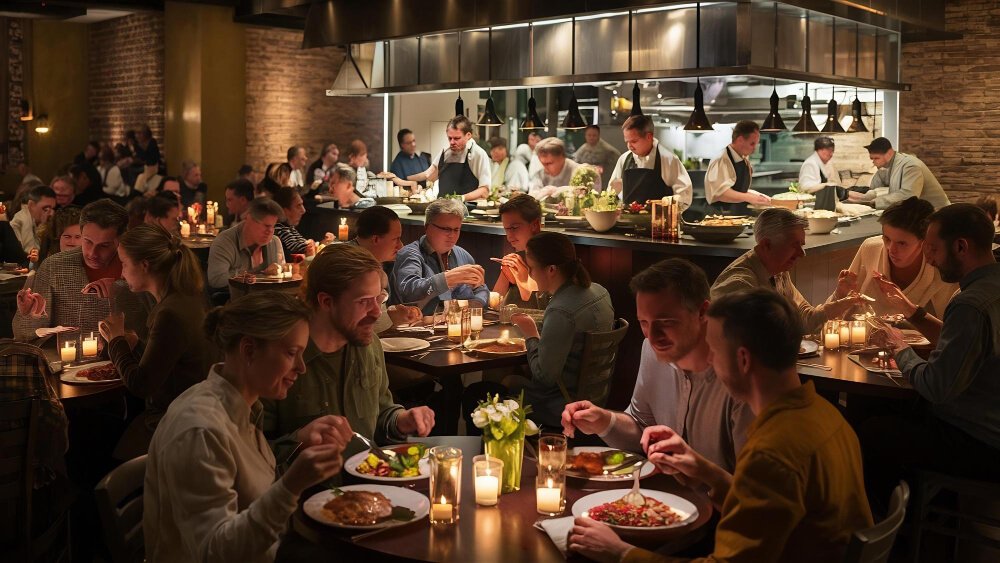Did you know that restaurant cancelations cost owners an average of $111 per customer who doesn’t show up?
That’s money walking straight out your door every time someone books a table and never arrives.
Unfortunately, this isn’t a small problem. In the UK hospitality industry, 12-14 percent of restaurant reservations go unfulfilled, resulting in staggering annual revenue losses of approximately £17.6 billion. For smaller establishments, even a couple of no-shows in restaurant can turn a profitable evening into a financial loss.
We understand the frustration. With the restaurant industry typically operating on thin profit margins, these unpredictable losses quickly add up if you don’t have a plan to handle them. In fact, unfulfilled reservations can result in revenue losses between 5% and 20%, while also leading to substantial food waste.
But here’s the good news – you don’t have to accept these losses as an inevitable part of running your restaurant. In this article, we’ll explore practical strategies to minimize no-shows, protect your revenue, and keep your tables filled, even when facing last-minute cancelations.
Why last-minute cancelations happen?
Understanding why guests fail to show up is the first step toward solving the empty table problem. According to research, restaurant no-shows happen for several specific reasons, each requiring different preventive approaches.
Forgetfulness and lack of reminders
Many diners simply forget they made a reservation, especially when booking well in advance. According to surveys, forgetfulness ranks among the top reasons for missed reservations. Without timely reminders, these bookings easily slip from guests’ minds amid busy schedules.
Studies show that sending a reminder 24–48 hours before a reservation significantly reduces no-shows. Nevertheless, many restaurants still don’t implement this simple yet effective practice, relying instead on customers’ memory—a risky strategy considering how quickly dining plans can fade from thought.
Sudden changes in plans
Life’s unpredictability represents another major cause of restaurant cancelations. As one industry expert notes, “A lot can happen between the time a guest makes a reservation and the moment they’re supposed to show up”.
Meetings run late, emergencies arise, and circumstances change unexpectedly. Even hospitality industry staff occasionally find themselves needing to cancel reservations at the last minute. Unfortunately, although guests remember to inform their dining companions about changes, they frequently forget to notify the restaurant itself.
OpenTable reports that approximately six percent of people who make phone reservations never show up—essentially “ghosting” the restaurant without any notification.
No clear cancelation process
Perhaps surprisingly, many no-shows occur simply because canceling proves too difficult. One Reddit user described spending hours trying to reach a restaurant to cancel their reservation. When faced with complicated cancelation procedures, many guests eventually give up trying.
Furthermore, some customers don’t cancel because they aren’t aware that their no-show impacts your business. Others struggle to find their booking details, making the cancelation process even more challenging.
Restaurants that make cancelations easy—particularly through digital means—see significantly lower no-show rates. According to industry data, when guests can cancel through confirmation emails with just a few clicks, they’re more likely to do so rather than simply not showing up.
How empty tables in restaurant hurt your business?
Empty tables represent far more than just unused space in your dining room. The financial drain of restaurant cancelations extends throughout your entire operation.

Lost revenue from missed bookings
The numbers tell a sobering story. Restaurant no-shows account for 5-20% of all bookings, creating a devastating financial impact. For a typical UK restaurant, this translates to approximately £1,325 in lost revenue over just two months.
Moreover, larger establishments like Vancouver’s Pidgin Restaurant reported losing an estimated $3,000 on Valentine’s Day alone when 20% of their reservations failed to materialize. The financial consequences become even more dire for smaller venues—those with limited seating capacity find that just a few absent parties can transform a profitable evening into a financial loss.
Wasted food and overstaffing
Beyond direct revenue losses, no-shows create a cascade of operational inefficiencies. Restaurants prepare ingredients and schedule staff based on anticipated guest numbers. Consequently, when diners fail to arrive, this precision quickly unravels into:
- Wasted food and unused ingredients
- Unnecessary labor expenses and overstaffing
- Reduced hours and lower tips for employees
Indeed, these issues can severely impact staff morale and productivity. During off-peak times specifically, restaurants still need adequate staffing to provide good service, resulting in underutilized staff and higher labor costs relative to revenue.
Impact on customer flow and reputation
No-shows disrupt more than just your expected revenue—they affect potential customers as well. When a reservation doesn’t appear on a busy night, you lose income from both the absent booking and walk-in customers who were turned away due to the supposedly occupied table.
This creates a double financial hit, as those deterred customers might not return for future visits. Additionally, the stress of managing no-shows forces staff to juggle between serving present guests and handling reservation issues, potentially leading to service mistakes.
First thing to remember: restaurant no-shows don’t just represent immediate lost revenue—they create a ripple effect throughout your entire business operation.
Proven ways to reduce no-shows in restaurants
Implementing strategic measures can dramatically decrease the frequency of restaurant no-shows. Research indicates that adopting the right approaches makes a substantial difference in keeping your tables filled.

Send booking confirmations and reminders
Studies show that forgetfulness accounts for a significant portion of missed reservations. Sending automated reminders 24-48 hours before bookings reduces no-shows considerably. These notifications give guests an opportunity to confirm their attendance or cancel in advance if needed. For reservations made several days ahead, consider sending the first reminder 48 hours prior, followed by a final SMS at noon the day before.
Make cancelations easy and online
Surprisingly, many guests don’t cancel simply because the process isn’t straightforward enough. When cancelation is seamless—like through a one-click link in confirmation emails—patrons are far more likely to notify you rather than simply not appearing. However, balance is key; making cancelations too effortless might encourage booking multiple venues simultaneously.
Use deposits or credit card guarantees
Financial accountability significantly reduces no-show rates. Credit card guarantees decrease unfulfilled bookings by an impressive 65%. When guests provide payment details upfront, they become more committed to honoring reservations. Restaurant Nobelhart & Schmutzig and Esszimmer virtually eliminated monthly revenue losses after implementing reservation deposits.
Set up a waitlist for last-minute fill-ins
Maintaining a digital waitlist allows you to quickly fill suddenly available tables. Modern reservation systems can automatically notify waitlisted customers when cancelations occur. Some platforms even allow filtering waitlists by party size or timeframe to efficiently match available tables.
Use customer reliability scores
Tracking guest history helps identify potential no-shows. Several booking systems now assign reliability scores based on previous behavior. These indices—often color-coded as green, orange, or red—enable staff to take preventive measures with guests who frequently miss reservations.
Set clear policies and use smart tools
A well-crafted cancelation policy forms the foundation of effective no-show management. Establishing clear guidelines protects revenue, optimizes resources, and sets proper guest expectations.
Create a simple cancelation policy
Effective policies include specific cancelation timeframes, no-show fees, and late arrival rules. Keep your policy concise and prominently visible on your website and reservation forms. Guests won’t read complex terms, hence focus on critical information like cancelation deadlines and deposit conditions.
Use online restaurant reservation systems with automation
Reservation platforms typically offer:
- Automated SMS/email reminders reducing no-shows by up to 32%
- Integration with payment systems for deposits
- One-click cancelation options
- Waitlist management for filling sudden vacancies
Modern systems even track guest preferences and visit frequency, enabling personalized service.
Track and analyze no-show patterns
Data analytics help predict booking patterns, customer behavior, and cancelation rates. Comprehensive reports provide real-time insights that support strategic decision-making. Subsequently, identifying repeat no-shows allows staff to manage unreliable diners more effectively.
Balance strictness with customer experience
Research confirms that cancelation policies negatively affect consumers’ restaurant evaluations, yet remain necessary. Generally, implementing lenient policies paired with guest education about no-show impacts offers the best results. Furthermore, maintaining flexibility for legitimate emergencies builds goodwill while preserving deterrent effects.
Conclusion
Last-minute cancelations undoubtedly represent a significant challenge for restaurant owners everywhere. Throughout this article, we’ve seen how no-shows can drain your profits, waste food, create staffing inefficiencies, and ultimately hurt your bottom line.
Fortunately, you don’t have to accept these losses as inevitable. By implementing a combination of strategic approaches, you can dramatically reduce empty tables and protect your revenue. Automated reminders address forgetfulness, while straightforward cancelation processes make it easy for guests to inform you when plans change. Additionally, financial accountability through deposits or credit card guarantees encourages commitment, turning tentative bookings into reliable reservations.
Most importantly, the right technology makes all the difference. Modern reservation systems offer powerful tools for sending reminders, managing waitlists, processing deposits, and tracking customer behavior. These platforms essentially transform potential losses into opportunities, allowing you to quickly fill tables when cancelations occur.
Remember that finding the right balance remains crucial. Overly strict policies might protect your revenue but could damage your reputation and guest relationships. Instead, aim for clear, reasonable guidelines paired with excellent communication about why these policies matter.
Empty tables don’t have to mean empty profits. With thoughtful strategies and the right tools, you can significantly reduce no-shows, maximize your revenue potential, and keep your restaurant thriving despite the occasional cancelation. After all, your focus should remain on creating exceptional dining experiences rather than worrying about who might not show up.
Key Takeaways
Restaurant no-shows cost an average of £111 per customer and account for 12-14% of all reservations, but strategic prevention methods can dramatically reduce these losses and protect your revenue.
• Send automated reminders 24-48 hours before reservations – This simple step significantly reduces forgetfulness, the top cause of no-shows
• Implement credit card guarantees or deposits – Financial accountability decreases no-shows by up to 65% while ensuring guest commitment
• Make cancelations easy with one-click online options – Simple cancelation processes encourage guests to notify you instead of simply not showing up
• Use reservation systems with waitlist automation – Smart technology can instantly fill canceled tables and track customer reliability patterns
• Balance clear policies with customer experience – Set reasonable cancelation deadlines and fees while maintaining flexibility for genuine emergencies
The key is combining multiple strategies rather than relying on just one approach. Modern reservation technology makes it easier than ever to automate reminders, process deposits, manage waitlists, and track guest behavior patterns. When implemented thoughtfully, these measures transform potential losses into opportunities, ensuring your tables stay filled and profitable even when plans change.
FAQs
Q1. How much do no-shows typically cost restaurants?
On average, restaurant no-shows cost owners about $111 per customer who doesn’t show up. This can result in revenue losses between 5% and 20% for restaurants.
Q2. What are the main reasons for last-minute cancelations?
The primary reasons include forgetfulness, sudden changes in plans, and lack of a clear or easy cancelation process. Many guests simply forget their reservations or face unexpected schedule changes.
Q3. How can restaurants effectively reduce no-shows?
Effective strategies include sending automated booking reminders, implementing credit card guarantees or deposits, making cancelations easy through online options, and using a waitlist system for last-minute fill-ins.
Q4. Are strict cancelation policies good for restaurants?
While cancelation policies are necessary, overly strict ones can negatively affect customer perceptions. It’s best to balance clear, reasonable guidelines with some flexibility for genuine emergencies to maintain good customer relationships.
Q5. What role does technology play in managing restaurant reservations?
Modern reservation systems offer crucial tools for reducing no-shows, including automated reminders, waitlist management, deposit processing, and customer behavior tracking. These technologies help transform potential losses into opportunities to keep tables filled.

